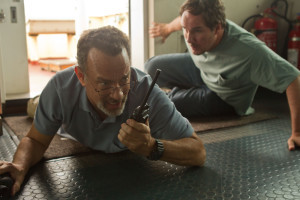The lore of pirates has been a focal point of entertainment for as long as mankind has been brave enough to venture out onto the high seas. From the animated Captain Hook in Disney’s 1953 “Peter Pan,” to Johnny Depp’s character Jack Sparrow, which has morphed into the billion dollar “Pirates of the Caribbean” franchise, pirates are generally depicted as peg-legged charismatic swashbucklers with pet parrots and eye patches who won’t rest in their search for gold and treasure.
While the aforementioned works of fiction are entertaining, they fail to capture the terror and true evil of real life pirates, who prey on helpless vessels as they voyage through enemy waters without a care or concern for anything, operating outside of the scopes of any laws. Pirates of today don’t fight with swords – they use machine guns.
Based on the true story of the 2009 hijacking of the Maersk Alabama by Somalian pirates, the 2013 thriller “Captain Phillips” delivers as a near flawless film that will leave the viewer sitting on pins and needles from start to finish.
We all lived through the events of the real life situation, but most of us probably didn’t know the specific details. Director Paul Greengrass welds two opposite worlds together in a masterful way, giving the viewer a firsthand glimpse of the collision course that became part of our culture and history.
Lifelong ship captain Richard Phillips (Tom Hanks) departs his home in Underhill, Vermont and boards a plane that will take him to Oman. Phillips will be taking the freighter MV Maersk Alabama from the Port of Salalah to Mombasa, Kenya with food, water, and supplies that will serve as humanitarian aid.

The experienced Phillips is aware of the potential danger as the route will take the unarmed ship on its own through the Somali basin. The enormous freighter sets out amidst pending doom and the voyage is quickly interrupted as the Maersk radar picks up pursuit from Somalian skiffs, one of which is commanded by pirate Abduwali Muse (Barkhad Abdi) and a handful of heavily armed men. Phillips radios for assistance and is informed simply to follow lockdown procedures. “Yeah…” Phillips replies as he recognizes that the Maersk is not only in danger, but completely isolated on the open Indian Ocean. “Is that it?”
“Captain Phillips” showcases the wide range of actor Tom Hanks, and vaults him to the top tier of Hollywood leading men. Hanks does a masterful job of showcasing fear while remaining composed and going to battle in a situation he’s trained for dozens of times but never actually experienced. Richard Phillips is not Rambo. Rather, he is a stoic seaman who relies on his mind, his experience, and his words to get him and his crew through the ordeal.
Hanks and Abdi forge a fascinating bond. Each man comes from a completely different background, and each is willing to do whatever it takes to survive. While Phillips operates with a mandate to safely deliver the cargo and keep his crew free from harm, Muse operates without the guidance of any law, and would sooner perish than return to Somalia without his prize in tow.
“Captain Phillips” was nominated for six Academy Awards but somehow failed to take one. The acting from Hanks alone is unforgettable and the story is full of drama, action, and excitement throughout. The intensity is so ripe you’ll find yourself sweating as it unfolds.
“Captain Phillips” should have won the Academy Award for Best Picture, as it was far and away the best film of the year.
by – Matt Christopher
1 Comment
Again I must agree with the reviewer .